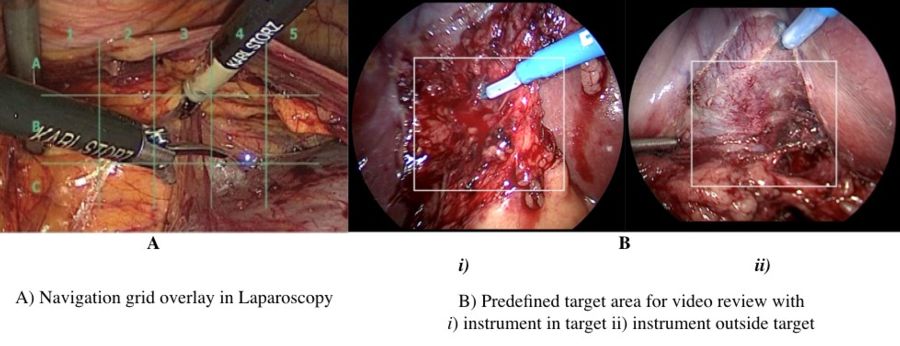PS9-05: THE IMPACT OF NAVIGATION GRID OVERLAY ON PERFORMANCE OF CAMERA ASSISTANTS DURING LAPAROSCOPIC ABDOMINAL PROCEDURES: A PROSPECTIVE RANDOMIZED STUDY
Iman Ghaderi, MD, MSc, MHPE, Eric Hines, Brooke Quinton, McKenna White, Amlish Gondal, MBBS; University of Arizona
Background: Camera navigation is an important component of laparoscopic surgery. Inadequate visualization of operative field can potentially compromise the operative flow and patient safety. The operating surgeons rely on their assistants for this task although it is often assigned to less-experienced members of the surgical team. Our aim was to determine whether Navigation Grid (NG) overlaying laparoscopic display monitor could improve camera navigation during various laparoscopic abdominal procedures.
Methods: Patients who underwent laparoscopic abdominal surgeries were randomized to with and without use of NG. The NG from IMAGE1 S device (KARL STORZ Endoskope) was used (Figure 1: A). A pre-defined target area (Figure 1: B) was embedded into recorded videos to provide a frame of reference for reviewers who were blinded to the use of navigation grid in the cases. Primary outcome of interest was the time that laparoscopic instruments were outside the target area (Figure 1: B). Power analysis using two-sided Fisher’s exact test was performed to calculate the sample size and a two-tailed t-test was used to determine the difference between the groups. For robotic assisted cases, only laparoscopic portions were included. Ten percent of collected videos were randomly selected to be reviewed by a second reviewer to establish inter-rater reliability.
Results: Seventy-two procedures were recorded; 36 with NG and 36 without. Nineteen camera assistants participated; 42% were PGY-1. Total video duration reviewed was 22.3 hours. Mean time outside the target area without NG was 335 ± 51 seconds per video whereas mean time outside the target area with NG was 286 ± 79 seconds per video (p= 0.002). Inter-reviewer reliability coefficient for video reviewers was 0.84 (CI: 0.82-0.89). The majority of subjects found the NG easy to use (94%) and helpful to understanding directions by the attending surgeon (76%). Only 38% found it distracting.
Conclusion: This navigation grid overlay improved performance of camera assistant during laparoscopic abdominal procedures. This system may provide a frame of reference for camera holders to better assist the operating surgeons during laparoscopic procedures although it may be perceived as distracting. A larger study with reduced intensities may address this issue.

